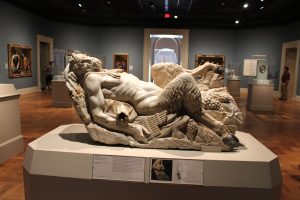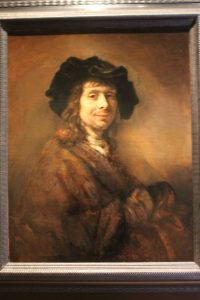In school, I opted for music and film appreciation, leaving my studies of art when the crayons got put away after the third grade.
My loss, because art appreciation is a wonderful spur for the imagination.
Still, it’s never too late to learn. During a recent visit to the St. Louis Art Museum, I met the following characters set in canvas and carved from stone.
Any NPCs for a future game? You decide.
Bakkhos, the satyr, king of the feast
Most satyrs establish their domain in vineyards and orchards. But Bakkhos is different. The king of the feast is the permanent guest in the estate garden of the Lady Phontine, a prominent Dionysus worshipper in the city. Bakkhos has adopted the persona of a “civilized” savage, a philosophical sage who offers small bits of what passes for wisdom to members of the Dionysus cult and other cultural elites that seek him out. The Lady Phontine has done much to cultivate and advertise this personality — the close association continues to elevate her social standing. At heart, though, Bakkhos remains the “king of the feast” whose nature is reflected in wildflowers in bloom, the bounty of the grape harvest and hours of idyllic leisure spent in green pastures. For him, a little wine, a few notes on the reed pipes and a charming personality are enough to turn a private conference into a carnal frolic. Imparted wisdom, indeed.
As a villain: A corruptor of the privileged classes who uses debauchery and leverage to further the aims of dark gods.
Teun, vagabond with a secret
Behind the knowing smile of Teun lies a secret. The secret changes from day to to day, of course. Buried treasure? Gossip about the gentry? Guild politics? He is a broker of information, seeking not coin, but influence and goodwill. He makes deals with casual acquaintances and longstanding friends. The easy-going fellow always seems at home, whether it is in a seedy tavern frequented by adventurers or mixing with the well-to-do at a fair or public exhibition. Handsome with a hint of beard, he conveys the bearing of a rogue, something women admire and men are comfortable with. He can handle himself in a scrape, usually sticking in a fight just long enough to prove himself stalwart, but always ready to extricate himself.
As a villain: A pre-eminent blackmailer of the rich and powerful.
Riders of the surround, brothers Psiris and Hei
Fortunate is the adventuring party, merchants, pilgrims or pioneers who have Psiris and Hei as their principal guides. The are accomplished trail blazers, capable scouts who not only have an unerring sense of direction, but can find passages navigable by the large wagons that are part of a merchant train.
Psiris, who wears light colored garb, is the elder. Confident and experienced, well into his middle years, he learned this craft from hard-won experience. Hei has been at his side only for a dozen years, benefiting from the elder brother’s experience, and has been spared more of the close calls that came from misjudgment. Hei talks wistfully of striking out on his own, to form his own company and train apprentices just as Psiris did with him. For his part, Psiris has known only the trail. Previous attempts to settle down have not worked out.
As villains: Scoundrels, who often as not, lead unsuspecting parties into ambushes or robbery by confederates, while maintaining their cover as “honest” guides.




















Psiris and Hei would work well in an Aces and Eights game too. I like the spark that leads you from art to NPC… there are interesting stories buried in those frames (and stone).
Most fantasy archetypes have Old West analogs. I was, in fact, thinking about unscrupulous guides from the pioneer era when I wrote that section. So happy trails with your Aces and Eights game!
Great article, Troy! I love that you took art and used that art to craft NPCs that fit the motif of the artwork used. The guides are my favorite, though the others are just fine. How about some statted out NPC sheets for these guys??? 😛
I suspect you already have the stats for these npcs, Andy. 😉 Much depends on your game and system you prefer, of course. But to illustrate how to get the most out of your d20 fantasy core books, using what they provide instead of crafting NPC stats yourself, here they are:
Bakkhos
3.0 DMG, use either bard (p.50), cleric (p.51) or druid (p.52) stats, level of your choice. Because there is no satyr adjustments, use the wild elf template from PC adjustment chart, making sure he can cast charm person, sleep and fear as a 10th level sorcerer or satyr from MM (p.160)
4.0 MM, satyr piper, p. 228
5.0 MM, satyr, piper variant, p. 267
PFRPG, NPC Codex, either dark nature priest (p77) or sylvan protector (p.63)
Teun
3.0 DMG, rogue (p55)
4.0 DMG, rogue npc template (p.188), or MM, halfling prowler (p.153)
5.0 MM, spy (p349)
PFRPG, NPC Codex, Dilettant (p.151) or iconic rogue (p.292-3)
Psiris and Hei
3.0 DMG, paladin (p.54)
4.0 MM2, human cavalier (p144)
5.0 MM, scout (p349)
PFRPG, NPC Codex, rider of the steppe (p121)
Great suggestion, Troy, I can make the core books do the heavy lifting for me!